Brain hemispheres and education: Left, right, and wrong
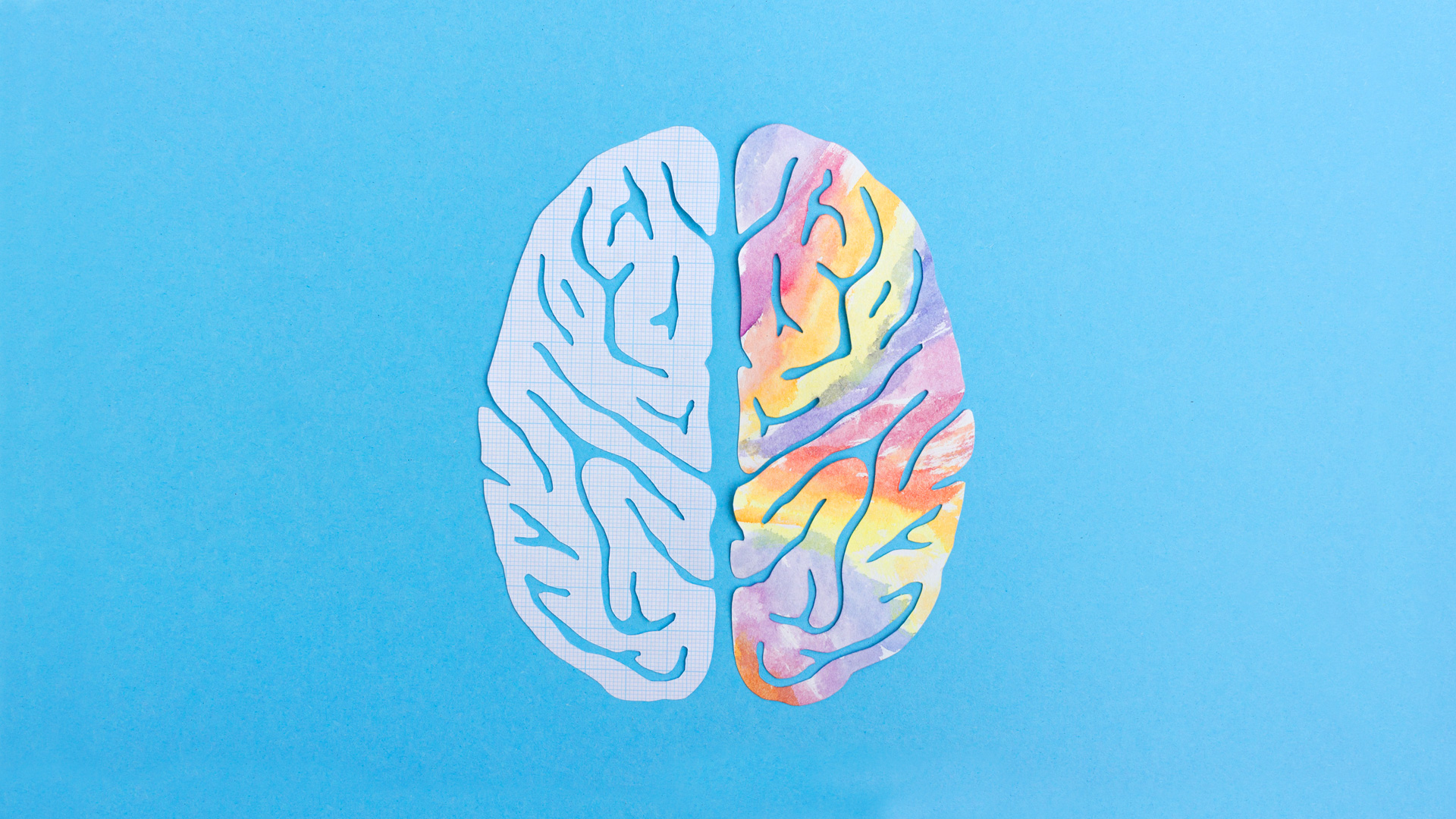
brain” learners.
Executive Summary
- Studies with split-brain patients showed that the two hemispheres of the brain process information differently
- This basic neuroscience research has been mistranslated into education
- Despite common belief, there are no “left-brain” or “right-brain” learners
- Expecting students to be “left-brain” or “right-brain” learners has potentially dangerous consequences
- Teacher expectations affect student outcomes
The evidence from neuroscience: left and right hemispheres
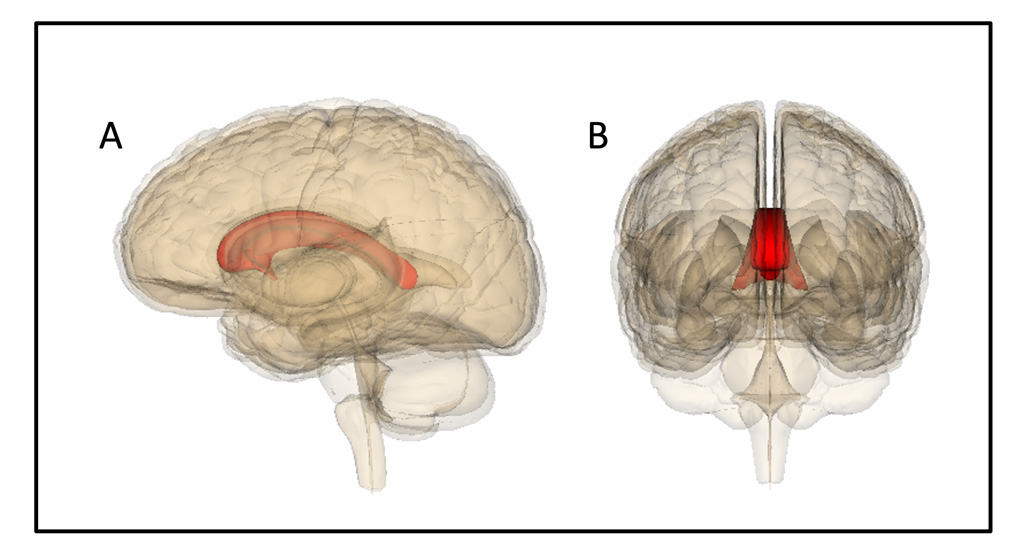
Figure 1. The corpus callosum (shaded red) as seen (A) from the side and (B) from the front. Life Science Databases(LSDB)/Wikimedia Commons, CC BY-SA 2.1 JP
The human brain is made up of two separate hemispheres: the left and the right hemisphere. They are connected by a massive bundle of about 200 million nerve fibers called the corpus callosum1. Figure 1 shows the corpus callosum (shaded red). From the front (Figure 1B), you can see the separation of the hemispheres and how the corpus callosum connects them in the middle. The corpus callosum carries information back and forth between the two hemispheres very quickly1,2. Because of this, under normal circumstances, it is almost impossible for one hemisphere but not the other to process the same information. But from clever experiments done with a special group of participants, we know that the two hemispheres process the same information in different ways.
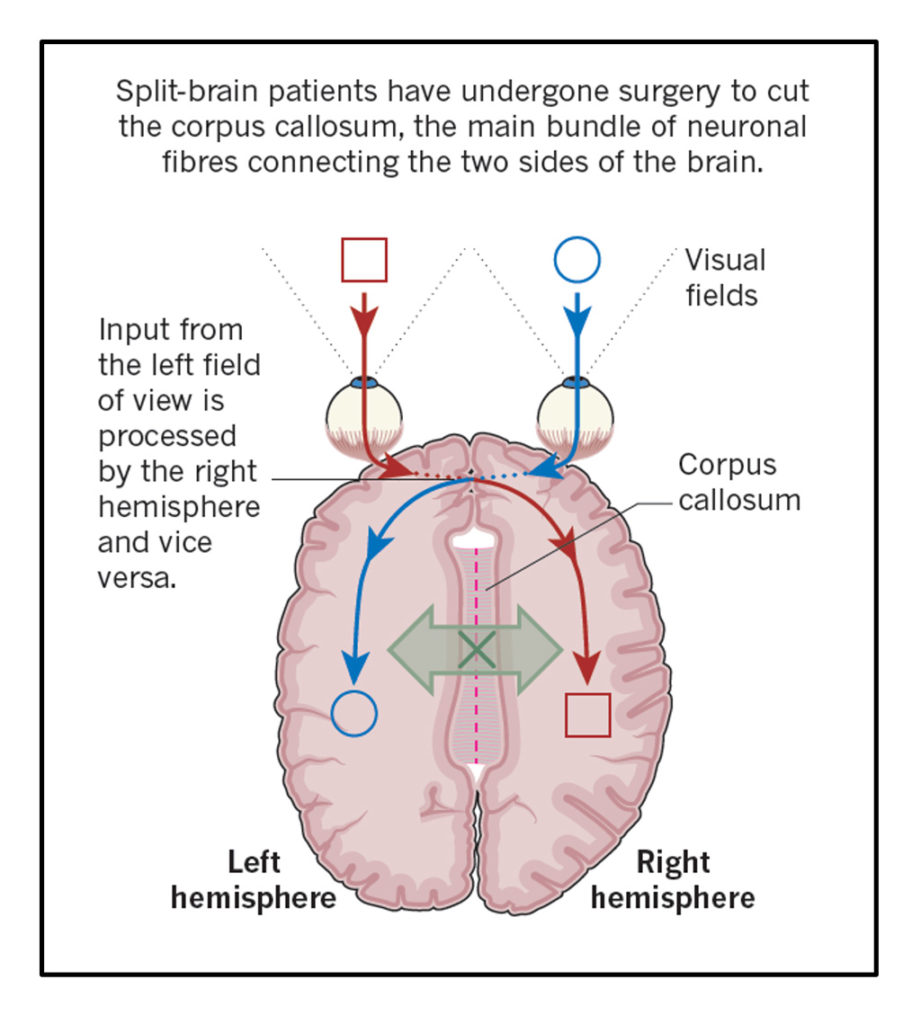
Figure 2. The crossover pattern such that information from the left visual field is processed by the right hemisphere (red pathway) and information from the right visual field is processed by the left hemisphere (blue pathway). The green X reminds us that the corpus callosum is severed in split-brain patients so that the hemispheres cannot share information. Reprinted by permission from RightsLink: Springer Nature from ref 3.
The special group of research participants who first revealed the inner workings of the two hemispheres was split-brain patients. Split-brain patients have had major neurosurgery to sever the corpus callosum. This is done for medical reasons, to stop the spread of severe seizures. The clever research design depended on the contralateral organization of the human brain. Contralateral organization simply means a crossover pattern. For example, the right hemisphere controls movement on the left side of the body, and the left hemisphere controls movement on the right side of the body. Similarly, information from the left visual field (what you can see on your left when you look directly forward out into space) is processed by the right hemisphere, and information from the right visual field is processed by the left hemisphere. Figure 2 illustrates this crossover pattern3.
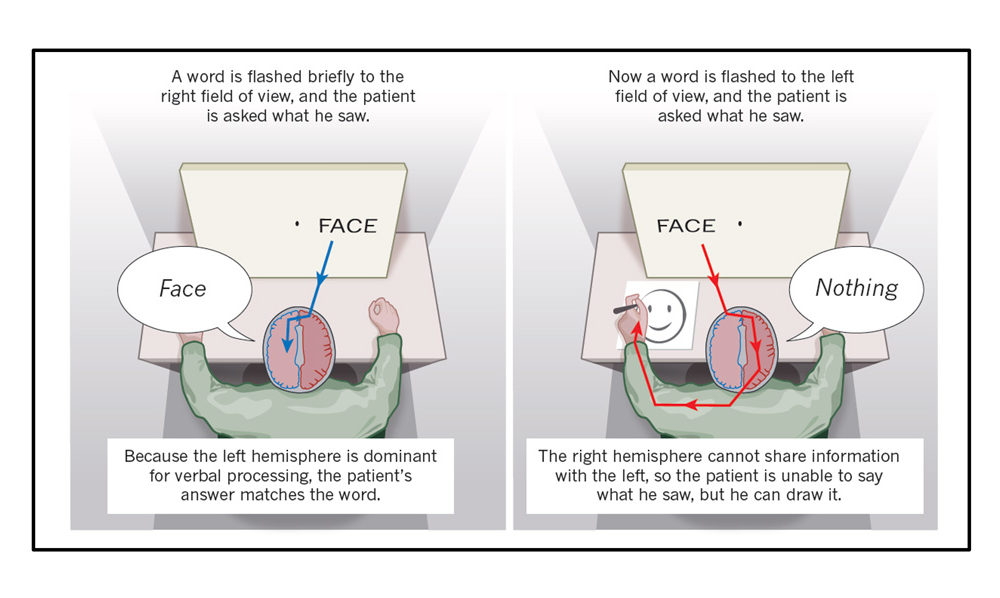
Figure 3. The experimental design of the studies with split-brain patients illustrating that the left hemisphere is specialized for speech articulation. Reprinted by permission from RightsLink: Springer Nature from ref 3.
In classic experiments4-6, split-brain patients were seated in front of a screen. They were asked to keep their eyes on a black dot at the center of the screen. The dot marked the separation of the left visual field (on the left side of the screen) from the right visual field (on the right side). Next, a word appeared very briefly on one side of the screen. Then patients were asked to say what they saw. The set-up is illustrated in Figure 3. When the word appeared on the right side of the screen, the information was sent to the left hemisphere and the patients were able to say the word when asked what they had seen. But when the word appeared on the left side of the screen, the information was sent to the right hemisphere and the patients were not able to verbally report what they had seen. However, if given a pen and asked to draw what they had seen with their left hand (controlled by the right hemisphere, which had received the word information on the screen), they were able to draw the meaning of the word. The researchers had found that the left hemisphere in adults was specialized for speech and the right hemisphere could recognize words but not articulate them. You can see a video of this experiment with a split-brain patient here. Roger Sperry received the 1981 Nobel Prize in Physiology or Medicine for this fascinating research on hemispheric specialization and how the human brain functions.
The mistranslation to education: there are no “left-brain” or “right-brain” learners
Educators are often enthusiastic about using findings from neuroscience in education 7. But the translation of brain research into teaching practice needs to be accurate and principled8,9. Sadly, the translation of the split-brain research into education has been neither. Instead, it has involved illegitimate mistranslation10. This prize-winning research, along with subsequent related researche.g., 11, has been distorted to become the mistaken belief that we have “right-brain” and “left-brain” learners in our classrooms who must be taught differently. Over 70% of teachers surveyed in the United Kingdom, the Netherlands, Turkey, Greece, and China believed in the myth of right- and left-brain learners12.
How did this happen? The left hemisphere ability to speak the word expanded to include analytical and logical thinking13,14. The right hemisphere ability to draw the word expanded to creative and emotional processing13,14. And each child supposedly had a “dominant” hemisphere that determined their way of thinking13,14. But just because research shows that the hemispheres are specialized4,6,15 does not mean that each is associated with a separate thinking style, or that one is dominant13,16. The ideas of hemispheric thinking styles and dominance are not based on science16-18. Yet this did not stop the proliferation of teaching techniques and educational programs designed to “access” either the left or right hemispheres of our students14,19-25.
There is no neuroscience research indicating that we need to (or even could) teach the hemispheres differently26. There is no scientific reason to spend precious, limited education funds on programs that make claims about training one or the other side of the brain. Insights into the “split brain” came from a handful of adult patients who had suffered severe seizures and undergone major neurosurgery4-6. We know that the intact corpus callosum in typically developing brains connects the two hemispheres so that they process information in parallel, in their own ways, at the same time1,2,11. In a typical classroom with a typical student, it is impossible to engage one hemisphere and not the other. All of the activities in our classrooms involve both hemispheres working together, without us needing to do anything special.
The dangerous educational consequences: the power of expectations
In the case of the left and right hemispheres, education has gotten the neuroscience wrong. But there is more at stake here than scientific error, waste of school funds on programs with no scientific merit, and squandering of time that could be spent using approaches that are actually effective27. If you are familiar with the Greek myth of Galatea or the musical My Fair Lady, you are familiar with the Pygmalion effect. In the context of education, the Pygmalion effect was first reported in a controversial28,29 study. In this study, researchers told teachers in an elementary school that they were developing a test that would predict which students would show unexpected cognitive growth over the school year (this was a lie)30-32. The students took the test at the beginning of the year. The researchers, without looking at the results, randomly chose about 20% to be “bloomers”: They told the teachers that scores on their test had predicted that these children would show intellectual gains that year. At the end of the school year, all the children took the test again. The test was actually just a basic IQ test. What the researchers found was stunning: The children whom teachers expected to make gains actually did make greater gains in IQ over the year30-32. The children randomly chosen to be bloomers did bloom, because the researchers had told the teachers that they would and therefore the teachers expected them to.
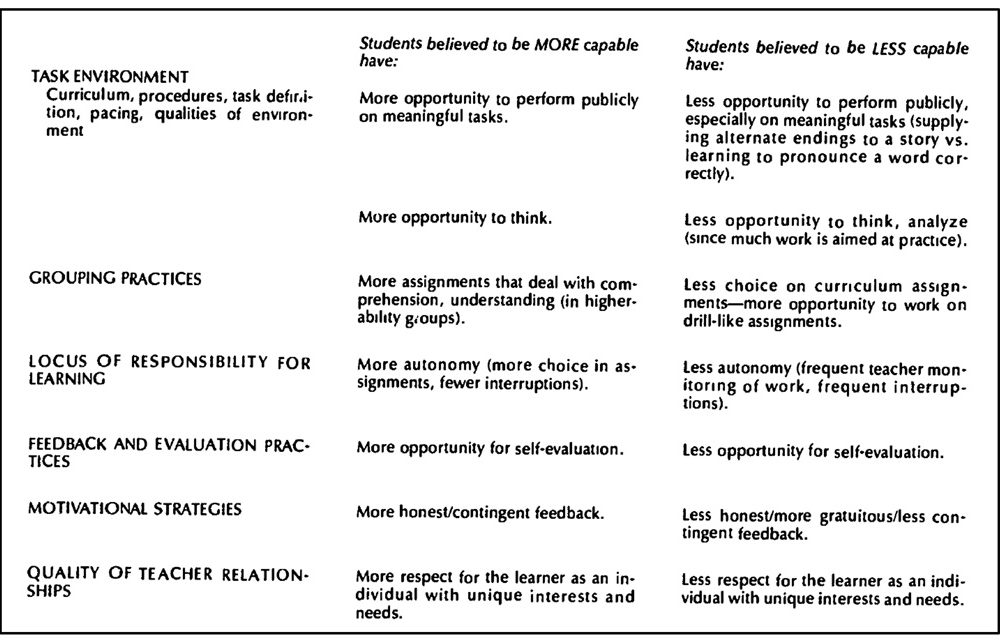
Table 1. Teachers communicate expectations by behaving differently towards students whom they believe to be more or less capable. Reprinted with permission from the Association for Supervision and Curriculum Development, Table 6.1, p. 72, in ref 39.
What we expect of our students matters; the ways in which we interact with students can actualize those expectations33-37. For example, teachers tend to communicate their expectations by behaving differently towards students whom they believe to be more or less capable (see Table 1)38,39. In essence, we tend to give students whom we expect to be more capable more opportunities for deep and purposeful learning. At the same time, we tend to shortchange the learning opportunities of students we believe to be less capable. We can also send subconscious signals about our expectations to our students, for example, through facial expressions and vocal tone36,40. Creating a supportive classroom climate, including quality teacher-student interactions and demanding teacher expectations, and providing engaging opportunities to learn are hallmarks of successful teaching41,42.
We have varying, often subconscious, expectations for the students in our classrooms every day. Some of these are related to equity. For instance, one study in the United States found that non-Black public high school teachers had lower academic expectations for their 10th-grade Black students than Black teachers did, ranking the same students 12 percentage points less likely to complete university education43. Another study in New Zealand found that primary school teachers had lower expectations for Māori students, as compared to students of other ethnicities44. What students become is in part dependent on what teachers expect of them – because of the learning opportunities and environment that we provide based on our expectations 38. Another name for the Pygmalion effect is self-fulfilling prophecy.
By expecting some students to be “left-brain learners” and think mostly logically and others to be “right-brain learners” and think mostly creatively, we limit all students’ opportunities to learn and grow. By falsely believing that there are left-brain or right-brain learners, we place students in boxes that may artificially narrow their interests or stop them from trying new things45. This could shape and limit children’s career paths and life choices from an early age46. Luckily, interventions that make teachers aware of the effects of expectations and the beliefs and behaviors underlying them can raise both teacher expectations and student achievement36,47,48. As educators, both our beliefs and our expectations need to be aligned with the fact that all of our students use all of their brains in our classrooms.
References
- Baynes, K. Corpus callosum. In Encyclopedia of the human brain Vol. 2 (ed V.S. Ramachandran) 51-64 (Elsevier Science, 2002).
- Doron, K. W., Bassett, D. S. & Gazzaniga, M. S. Dynamic network structure of interhemispheric coordination. Proceedings of the National Academy of Sciences 109, 18661-18668, doi:10.1073/pnas.1216402109 (2012).
- Wolman, D. A tale of two halves. Nature 483, 260-263, doi:10.1038/483260a (2012).
- Gazzaniga, M. S. The split brain in man. Sci. Am. 217, 24-29, doi:10.1038/scientificamerican0867-24 (1967).
- Sperry, R. W. The great cerebral commissure. Sci. Am. 210, 42-53, doi:10.1038/scientificamerican0164-42 (1964).
- Sperry, R. W. Hemisphere deconnection and unity in conscious awareness. Am. Psychol. 23, 723-733, doi:10.1037/h0026839 (1968).
- Pickering, S. J. & Howard-Jones, P. Educators’ views on the role of neuroscience in education: findings from a study of UK and international perspectives. Mind, Brain, and Education 1, 109-113, doi:10.1111/j.1751-228X.2007.00011.x (2007).
- Ansari, D. & Coch, D. Bridges over troubled waters: education and cognitive neuroscience. Trends in Cognitive Sciences 10, 146-151, doi:10.1016/j.tics.2006.02.007 (2006).
- Donoghue, G. M. & Horvarth, J. C. Translating neuroscience, psychology and education: an abstracted conceptual framework for the learning sciences. Cogent Education 3, 1267422, doi:10.1080/2331186X.2016.1267422 (2016).
- Lindell, A. K. & Kidd, E. Why right-brain teaching is half-witted: a critique of the misapplication of neuroscience to education. Mind, Brain, and Education 5, 121-127, doi:10.1111/j.1751-228X.2011.01120.x (2011).
- Tzourio-Mazoyer, N. & Seghier, M. L. The neural bases of hemispheric specialization. Neuropsychologia 93, 319-324, doi:10.1016/j.neuropsychologia.2016.10.010 (2016).
- Howard-Jones, P. A. Neuroscience and education: myths and messages. Nature Reviews Neuroscience 15, 817-824, doi:10.1038/nrn3817 (2014).
- OECD. Understanding the brain: the birth of a learning science. (Organisation for Economic Co-operation and Development, 2007).
- Sousa, D. A. How the brain learns. 3rd edn, (Corwin Press, 2006).
- Cai, Q., Van der Haegen, L. & Brysbaert, M. Complementary hemispheric specialization for language production and visuospatial attention. Proceeding of the National Academy of Sciences 110, E322-E330, doi:10.1073/pnas.1212956110 (2013).
- Beaumont, J. G., Young, A. W. & McManus, I. C. Hemisphericity: a critical review. Cognitive Neuropsychology 1, 191-212, doi:10.1080/02643298408252022 (1984).
- Corballis, M. C. Laterality and myth. Am. Psychol. 35, 284-295, doi:10.1037/0003-066X.35.3.284 (1980).
- Nielsen, J. A., Zielinski, B. A., Ferguson, M. A., Lainhart, J. E. & Anderson, J. S. An evaluation of the left-brain vs. right-brain hypothesis with resting state functional connectivity magnetic resonance imaging. PLoS ONE 8, e71275, doi:10.1371/journal.pone.0071275 (2013).
- Allen, K.-A. & van der Zwan, R. The myth of left- vs right-brain learning. International Journal of Innovation, Creativity and Change 5, 189-200 (2019).
- Farmer, L. S. J. Left brain, right brain, whole brain. School Library Media Activities Monthly 21, 27-28, 37 (2004).
- Gallagher, S. H. Left-brained versus right-brained: which is best for learning? The National Teaching & Learning Forum 14, doi:10.1002/ntlf.10080 (2005).
- Kitchens, A. N., Barber, W. D. & Barber, D. B. Left brain/right brain theory: implications for developmental math instruction. Review of Research in Developmental Education 8 (1991).
- Lord, T. R. A plea for right brain usage. Journal of College Science Teaching 14, 100-102 (1984).
- Sonnier, I. & Kemp, J. B. Teach the left brain and only the left brain learns — teach the right brain and both brains learn. Southern Journal of Educational Research 14, 63- (1980).
- Steinley, G. Left brain/right brain: more of the same? Language Arts 60, 459-462 (1983).
- Alferink, L. A. & Farmer-Dougan, V. Brain-(not) based education: dangers of misunderstanding and misapplication of neuroscience research. Exceptionality 18, 42-52, doi:10.1080/09362830903462573 (2010).
- Riener, C. & Willingham, D. The myth of learning styles. Change 42, 32-35, doi:10.1080/00091383.2010.503139 (2010).
- Thorndike, R. L. Reviewed work(s): Pygmalion in the classroom by Robert Rosenthal and Lenore Jacobsen. American Educational Research Journal 5, 708-711, doi:10.2307/1162010 (1968).
- Raudenbush, S. W. Magnitude of teacher expectancy effects on pupil IQ as a function of the credibility of expectancy induction: a synthesis of findings from 18 experiments. J. Educ. Psychol. 76, 85-97, doi:10.1037/0022-0663.76.1.85 (1984).
- Rosenthal, R. & Jacobson, L. Pygmalion in the classroom. (Crown House Publishing Limited, 1992).
- Rosenthal, R. & Jacobsen, L. F. Teacher expectations for the disadvantaged. Sci. Am. 218, 19-23, doi:10.1038/scientificamerican0468-19 (1968).
- Rosenthal, R. & Jacobsen, L. Pygmalion in the classroom. Urban Review 3, 16-20, doi:10.1007/BF02322211 (1968).
- Good, T. L. Teacher expectations and student perceptions: a decade of research. Educational Leadership28, 415-422 (1981).
- Johnston, O., Wildy, H. & Shand, J. A decade of teacher expectations research 2008-2018: historical foundations, new developments, and future pathways. Australian Journal of Education 63, 44-73, doi:10.1177/0004944118824420 (2019).
- Rosenthal, R. & Rubin, D. B. Interpersonal expectancy effects: the first 345 studies. The Behavioral and Brain Sciences 1, 377-415, doi:10.1017/S0140525X00075506 (1978).
- Rubie-Davies, C. M., Peterson, E. R., Sibley, C. G. & Rosenthal, R. A teacher expectation intervention: modelling the practices of high expectation teachers. Contemp. Educ. Psychol. 40, 72-85, doi:10.1016/j.cedpsych.2014.03.003 (2015).
- Weinstein, R. S. Pygmalion at 50: harnessing its power and application in schooling. Educational Research and Evaluation 24, 346-365, doi:10.1080/13803611.2018.1550842 (2018).
- Good, T. L. Two decades of research on teacher expectations: findings and future directions. Journal of Teacher Education 38, 32-47, doi:10.1177/002248718703800406 (1987).
- Good, T. L. & Weinstein, R. S. Teacher expectations: a framework for exploring classrooms. In Improving teaching (1986 ASCD Yearbook) (ed K. Zumwalt) 63-85 (Association for Supervision and Curriculum Development, 1986).
- Babad, E., Bernieri, F. & Rosenthal, R. When less information is more informative: diagnosing teacher expectations from brief samples of behaviour. Br. J. Educ. Psychol. 59, 281-295, doi:10.1111/j.2044-8279.1989.tb03103.x (1989).
- Brophy, J. Teaching. Education Practices Series—1. (International Bureau of Education,
- International Academy of Education, Geneva, Switzerland, 2000).
- Coe, R., Aloisi, C., Higgins, S. & Major, L. E. What makes great teaching? Review of the underpinning research. (Sutton Trust, London, UK, 2014).
- Gershenson, S., Holt, S. B. & Papageorge, N. W. Who believes in me? The effect of student-teacher demographic match on teacher expectations. Economics of Education Review 52, 209-224, doi:10.1016/j.econedurev.2016.03.002 (2016).
- Rubie-Davies, C., Hattie, J. & Hamilton, R. Expecting the best for students: teacher expectations and academic outcomes. Br. J. Educ. Psychol. 76, 429-444, doi:10.1348/000709905X53589 (2006).
- Newton, P. M. The learning styles myth is thriving in higher education. Frontiers in Psychology 6, 1-5, doi:10.3389/fpsyg.2015.01908 (2015).
- Chambers, N., Kashefpakdel, E. T., Rehill, J. & Percy, C. Drawing the future. (Education and Employers, London, UK, 2018).
- de Boer, H., Timmermans, A. C. & van der Werf, M. P. C. The effects of teacher expectation interventions on teachers’ expectations and student achievement: narrative review and meta-analysis. Educational Research and Evaluation 24, 180-200, doi:10.1080/13803611.2018.1550834 (2018).
- Rubie-Davies, C. & Rosenthal, R. Intervening in teachers’ expectations: a random effects meta-analytic approach to examining the effectiveness of an intervention. Learning and Individual Differences 50, 83-92, doi:10.1016/j.lindif.2016.07.014 (2016).